Rachel Sabino has the hands of an artist, with fingers that seem more jointed and knowledgeable than other peoples’. She is demonstrating how broken pieces of terracotta will be fitted on to mounts that she and a colleague have built to support the Madonna and the shepherds, and how the original terracotta fits together, but not entirely, in some places more tightly than in others. On the floor, the work is laid out in a large arch, which is right now mostly a two-dimensional map of odd black shapes; at its periphery are the shelved lumps of terracotta in luminous white, yellow, green, and blue. Sabino describes with a kind of appalled affection the efforts made by conservators of 100 years ago, who actually drilled screws into the back of these pieces, which weakened the initial faults made in firing, and in some places have riven the terracotta apart. Conservators labour over objects physically formed by past interpretations; Sabino is working to make a Benedetto Buglioni appear again.
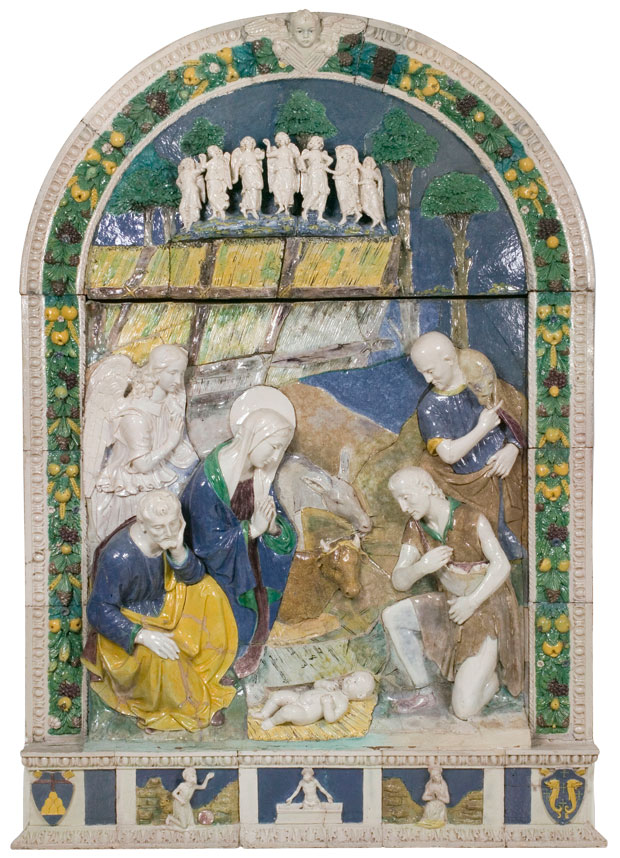
Altarpiece depicting the Adoration of the Shepherds (c. 1520), Benedetto Buglioni and Santi Buglioni. Art Institute of Chicago
Sabino is one of a large team of conservators and curators working behind the scenes of the new Deering Family Galleries of Medieval and Renaissance Art, Arms, and Armor at the Art Institute of Chicago, which will open to the public on 20 March. During the afternoon I spend there, Martha Wolff, the curator who has overseen this enormously complex reinstallation, tells me about the various ways they are trying to recontextualise the works of art and make them newly available for museum-goers. She, too, seems to love the physical stubbornness of the objects, and the way they insist on their own history. On the day I visit, most of the pieces are not yet there, but in Wolff’s mind the materials resonate with one another – the only extant medieval embroidered altarpiece from Spain will echo against another painted in egg tempera, as it will against cut velvet, steel, and ceramic. ‘We really did it,’ she says, ‘in service of the objects.’
When you walk into the first room of the new galleries, you will see the Ayala Altarpiece. ‘Truly one of the great masterpieces of our collection,’ James Rondeau, the museum’s director, says in conversation later. ‘Artists who live in Chicago associate it with coming to the museum over a long time.’ The altarpiece was commissioned in 1396 by Pedro López de Ayala and his wife, Leonor de Guzmán, for their family funeral chapel, and remained in Castile in northern Spain, in the family’s hands, for 500 years, until the upheavals before the First World War began to bring so many European masterworks into American hands. It was purchased in 1913 by Chicago farm-equipment magnate Charles Deering, who lived in Spain at his mansion in Sitges, avidly collecting art, some of which was recommended to him by avant-garde Spanish artists and critics such as Ramón Casas and Miquel Utrillo. Deering died in 1927, and the altarpiece passed to the Art Institute, through his daughters, along with a large part of his collection of some 4,000 works of art.
The Ayala Altarpiece, especially the background of the figures, was probably heavily ‘conserved’ with a thick layer of oil-based tan overpaint, right around the time it left the chapel and came to Deering. The oil base of the added paint ‘was good news for conservation’, Julie Simek (another conservator) wrote in a post for the Art Institute’s blog: it ‘allowed us to devise a cleaning solution that solubilizes the oil paint without affecting the underlying original tempera’. The process took three and a half years. The retable has 16 small, almost square, scenes from the life of Christ, each in a gilded gothic arch frame, and the frontal below has a further three scenes. The tan has been returned to something Simek believes to be much closer to the original cream colour, and this makes the dusky roses and soft blues of the robed and haloed figures more luminous.
The altarpiece is being installed in the first gallery during my visit and Simek, in a blue lab coat, is up on a ladder working to get it level. The whole gallery has been designed around the piece. The room is painted dark grey and Charles Mack Design has given the spaces suggestions of ledges and vaults. You will look straight across at the frontal, and up to the retable, which, at some 21 feet in length seems like a panorama of another world.
In conjunction with the opening of the medieval and Renaissance galleries, there will be a small exhibition in the Art Institute’s Ryerson Library about some of the people whose collections play a central role in the reinstallation. These include Charles Deering, Martin Ryerson, the Palmer family, and George F. Harding, Jr., whose vast collection of arms and armour came to the museum in the 1980s. Although in most American museums one feels the presence of donors, this may be slightly more the case at the Art Institute, which from its inception honoured its donors by keeping collections together. It still contains many bequests – the Lindy and Edwin Bergman collection of Joseph Cornell boxes, the miniature rooms that Mrs James Edward Thorne conceived and had built, and, most recently, the Edlis/Neeson collection of contemporary paintings – that are still displayed together and bear the imprint of their collectors’ sensibilities. Collecting may become another way, like curating and conserving, of placing a collage or a helmet within new layers of historical interpretation.
If it is possible to identify a particular Chicago taste, one might note that Chicago’s sympathies, and pockets – which were deep, although not always quite as deep as some of their East Coast competitors – were drawn early on towards art slightly more contemporary or peripheral. The great Chicago collections of Impressionism were formed while the paint was still wet, and the Art Institute has a number of pieces that came directly from the radical Armory Show of 1913 – a show that travelled to a few cities and, when it did, was usually hosted at a hired hall by interested private patrons; the Art Institute was the only museum to host it. Chicago patrons were also early to turn to historical works admired by the Impressionists and the European avant-garde: art from Spain. Many of the finest and most unusual pieces in the new Deering galleries are Spanish, and this connects the galleries to the next-door European paintings galleries, which also have strong Spanish holdings. It is typical of the collectors working on behalf of the Art Institute that in 1906, under Mary Cassatt’s careful guidance, they bought El Greco’s Assumption of the Virgin (c. 1677/79) from the Galérie Durand-Ruel. The painting tells a story of abstraction, fervour, and displacement that rings through the whole museum.
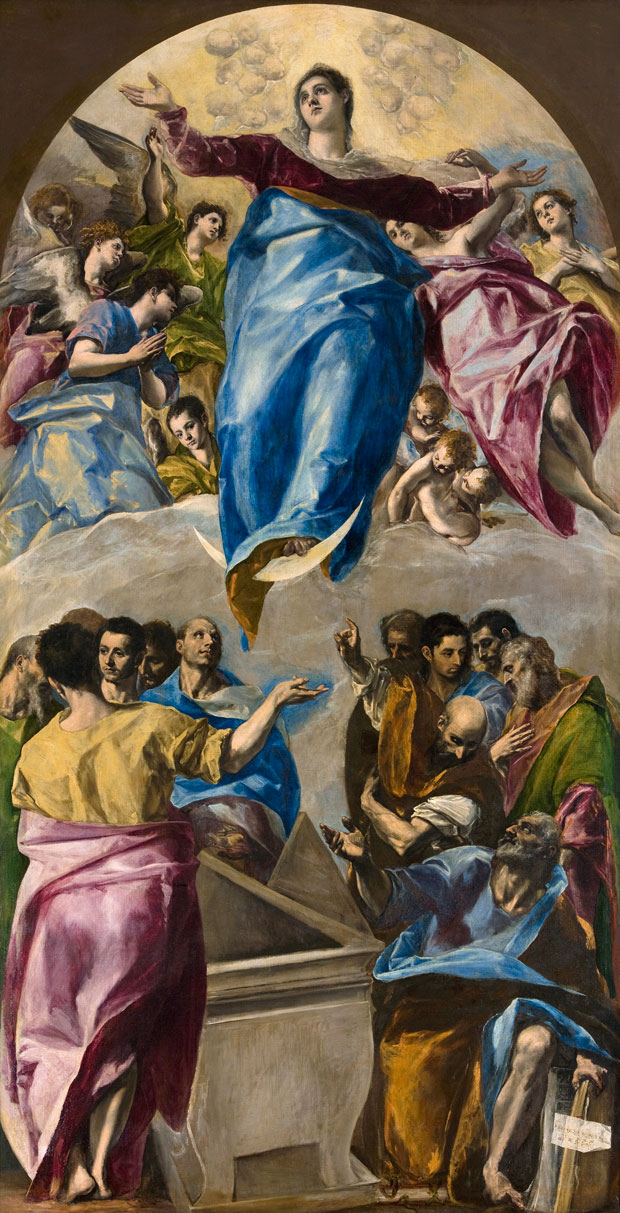
The Assumption of the Virgin (c. 1577/79), Domenikos Theotokopoulos, known as El Greco. Art Institute of Chicago
Mary Cassatt’s enthusiastic letter about the El Greco is prized by the Art Institute’s archivist, Bart Ryckbosch, not only for its historical significance, but because of how it communicates enthusiasm – he always shows it to groups of high-school students. He tells me, with cheerful solemnity, that one of the biggest projects at the Art Institute in the last 10 years has not been any particular building or acquisition, but the reorienting of its collection – down to which pieces of documentation the archive chooses to digitise – toward visitors, real and virtual.
It is interesting to see how the view taken by a museumgoer in 2017 will grow around interpretations that were current when the Art Institute was forming the core of its collections, from roughly 1900 until the 1930s. Collectors and artists then were interested in Spanish traditions of depicting gesture, pattern, and movement of all kinds. This was the time not only of Picasso, and of the conflicts that would inform the Spanish Civil War, but of Arthur Kingsley Porter’s 10-volume masterpiece Romanesque Sculpture of the Pilgrimage Roads (1923), through which Spain was being understood as a place of movements and intersections. In our own time, it again seems important to think about the connections between Spanish art and the formation of Impressionist and abstract art sensibilities, to study the long history of links between Spanish art and the Islamic art of the Arab world, and to consider the conversation between indigenous art in South America and colonial art of the religious orders.
It is hard to tell to what extent one will feel these movements of goods, craft, and people, when the artworks and armour are in place, but the plans include a screen installation that will draw maps of the movements of the religious orders, of Hapsburg political activity, and of the patterns of trade that moved both the art objects and the materials from which they were made around the globe. Further context will be drawn out in the adjacent galleries of European painting by exhibitions like one currently on view, ‘Doctrine and Devotion: Art of the Religious Orders in the Spanish Andes’ (until 25 June), curated by Rebecca Long, who has also been involved in the reinstallation. And, when you walk out of European Decorative Arts, you will either go to European paintings, passing by the El Greco, or into Impressionism, where you can see the ways in which Cassatt, Manet, and Cézanne reconsidered these traditions. The Deering Family Galleries thus become a way to hold in mind the whole museum, as it once was and as it is now.
As you stand in front of the Ayala Altarpiece, your left peripheral vision will become aware of a straight sightline, taking in the great Martorell altarpiece of Saint George Killing the Dragon (1434–35), which is also a Deering contribution. Your eye probably won’t stop only there, because it will be drawn on to two lifesize horses in armour. Arms and armour, a perennial favourite at the Art Institute, used to be displayed in the long gallery that is suspended over the railroad tracks and connects the original buildings to the recently opened modern wing, designed by Renzo Piano. This long gallery now shows a fine collection of South Asian sculpture. For many years, only a few arms and armour pieces have been on display. But the collection has recently been taken in hand by Jonathan Tavares, who has been judiciously filling out gaps, researching the existing pieces, and reconceiving what arms and armour may demonstrate more generally at the museum.
The horses, Tavares explains, were sculpted by David Hayes, a renowned horse sculptor, based on close observation at a stud farm of Lipizzaner horses. The sculpted horses wear their armour with impressive vigour, and, during my visit, they are being caparisoned in delicate silks, designed by the School of Historical Dress in London; two installation workers are patiently winding silk thread into tassels and attaching dozens of these at key junctures in the fabric. At the edge of the room, two mannequins, also in full armour and velvet doublets, are engaged in a hand-to-hand bout typical of tournament activity. Apparently, the mannequin builder had trouble getting a pose for the figure on the left that would give the sense of how the armour was meant to move. In the end Tavares, who is of relatively slight build, donned the armour to work out the gesture and stance so that the mannequin-maker could work backward towards the body of the man for whom it had been made.
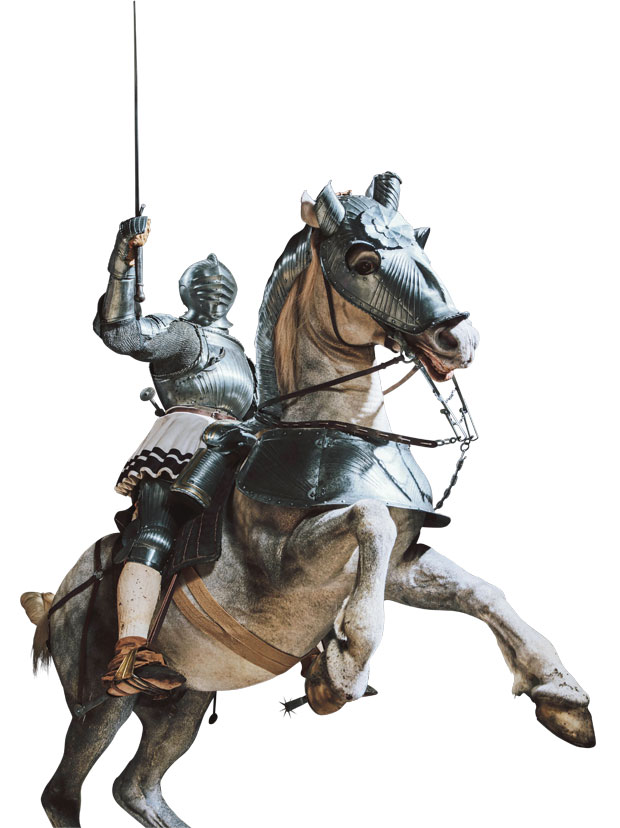
Armour for man and horse (c. 1520), with modern costume, Nuremberg, Germany. Art Institute of Chicago
The ephemerality of ordinary wool and clay means that there is very little in the galleries of the everyday life of people who were not unusually wealthy. The enduring quality of armour, by contrast, means that something of the way people moved and dressed, understood the human body, surrounded it with cloth, and even attacked it, can be reproduced. Perhaps not all fashion belongs in a museum, but costume’s great potential for historical theatricality, brilliantly made use of in the Art Institute’s installation, may aid the artistic imagination, and also be of great help when one returns to paintings and sculptures.
Conservation as historical inquiry can require a cast of thousands – equestrian trainers, cabinet designers, tassel-winders. In James Rondeau’s words, this makes for ‘unexpected adjacency’, not only of objects, but of fields of inquiry. Rondeau speaks with delight of the museum’s conservation spaces, its seven or eight different scientific laboratories, and the fact that the Art Institute is one of only three museums in the US that is also an active school of art and art history. ‘One of the things I’ve been starting to talk about here is embracing the notion of our museum as an institute.’ It was renamed from ‘museum’ to ‘institute’ in the 1880s, and ‘the trustees very, very knowingly embraced that word “institute”.’ Rondeau describes the combined effort of curators, conservators, art students, archivists, historians, data researchers, digital media specialists, designers, and craftspeople, as a dynamic ecosystem. That’s the constant. ‘In each case when we embark on a project of refinement or expansion, we do that as an ecosystem.’
This thought about the museum’s way of approaching objects from all periods and places was part of the answer to something I had been wondering about – how does the Art Institute see the relationship between the medieval and Renaissance installation and its recent significantly expanded attention to the contemporary? In addition to the new modern wing, there is the gift of the 20th-century works in the Edlis/Neeson collection, the elevation of Rondeau himself, who oversaw the installation of the new works in the new wing, to be the museum’s director, and the hiring of Ann Goldstein as deputy director and curator of modern and contemporary art. In the last six months, Art Institute exhibitions have included a surprising look at America in the 1930s, a Moholy-Nagy retrospective, an insightful show about the collaboration of Gordon Parks and Ralph Ellison, and a revelatory one about South African artist Kemang Wa Lehulere. The modern wing’s new galleries devoted to architecture and design, which will roll out a broad re-envisioning of 20th and 21st-century work drawing on the whole of the museum’s collections next September, are currently running, among other things, a room installation called ‘Who Builds Your Architecture?’ (created by an eponymous collective) about the mistreatment of migrant workers in contemporary skyscraper building.
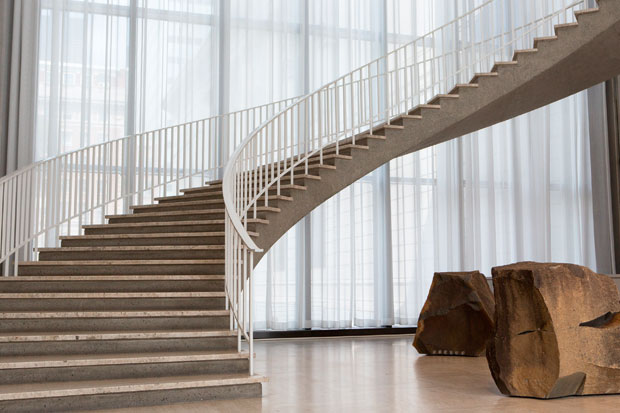
View of Islands (Shima tachi) (2000), Izumi Masatoshi, at the foot of the Morton Staircase at the Art Institute of Chicago.
All these shows, in a way relentlessly modern, were also about poverty, about working with limited materials, and about the ways in which objects might help us to carry a sense of ourselves even in times of migration and upheaval. The shows are also about ways that museums and people turn over their history. The new modern wing has allowed for many of the museum’s other collections to be reinstalled, and this brings out new and old connections. The Morgan building, where the medieval and Renaissance art is to live, was built in 1962 to house modern art. Another way to arrive at the Deering Family Galleries will be to go through Asian art, which is on the ground floor of the Morgan wing, until you come to an atrium where there are three sculptures cleaved from one stone. In ‘Islands (Shima tachi)’, Izumi Masatoshi has carefully left the stone rough to make ‘a contemporary work that upholds the traditional Japanese reverence for natural materials’. From here you will be able to take the spiral staircase up to the high windowless blackbox rooms that have been reset to carry the viewer into the atmosphere of life as it was prayed and studied and fought over five or six hundred years ago.
When I take my children to the museum, we often end near the entrance of the Renzo Piano wing in the big area for family and education where children can use building blocks, and draw still lifes and, in one room, make stencils with markers on the walls. ‘One thing I really appreciate about the Art Institute,’ says Jessica Stockholder, my colleague at the University of Chicago, where she is the chair of the Department of Visual Arts, ‘is its accessibility. It’s the city’s living room.’ Living rooms are open to refashioning, which for conservators and contemporary viewers, may not be so far from having a sense of play.
You walk out of the Deering Galleries the same way you walk in, so you get a chance to work with everything again. The horses with their silken tassels, the jewel cabinet and the embroidered altarpiece, the screen that explains trade routes, and the great Ayala Altarpiece. Here they are, old and new companions in a long history of knowledge and movement.
The Deering Family Galleries of Medieval and Renaissance Art, Arms, and Armor at the Art Institute of Chicago will open on 20 March 2017.
From the March issue of Apollo. Preview and subscribe here.
Unlimited access from just $16 every 3 months
Subscribe to get unlimited and exclusive access to the top art stories, interviews and exhibition reviews.





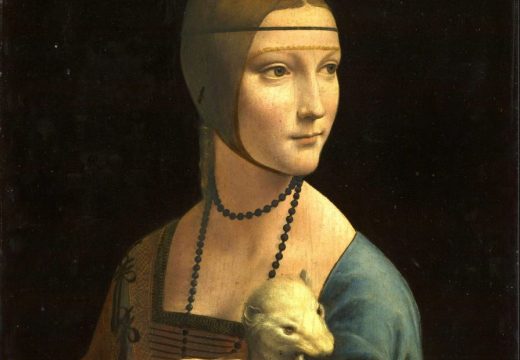
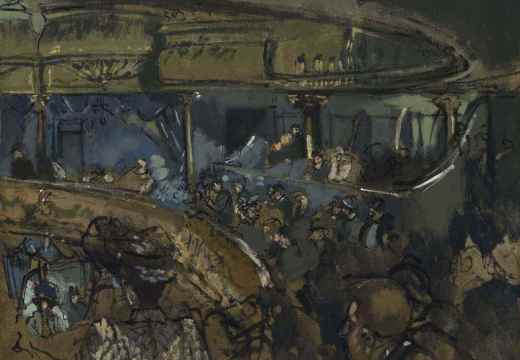










![Masterpiece [Re]discovery 2022. Photo: Ben Fisher Photography, courtesy of Masterpiece London](http://www.apollo-magazine.com/wp-content/uploads/2022/07/MPL2022_4263.jpg)
It’s time for the government of London to return to its rightful home